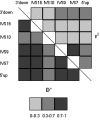Common variation in EMSY and risk of breast and ovarian cancer: a case-control study using HapMap tagging SNPs
- PMID: 16029503
- PMCID: PMC1185523
- DOI: 10.1186/1471-2407-5-81
Common variation in EMSY and risk of breast and ovarian cancer: a case-control study using HapMap tagging SNPs
Abstract
Background: EMSY could be involved in low-level susceptibility to breast and ovarian cancer. Gene amplification is seen in a proportion of breast and ovarian tumours and correlates with poor prognosis in breast cancer patients. Furthermore, the EMSY protein silences a transcription activation domain in BRCA2 exon 3.
Methods: We used a genetic association study design to determine if common genetic variation (frequency > or = 5%) in EMSY was associated with breast or ovarian cancer risk in the British population. Haplotype tagging single-nucleotide polymorphisms (htSNPs) were selected from the HapMap database and genotyped using Taqman in two large study sets of white British women (n [breast set] = 2343 cases and 2284 controls, n [ovarian set] = 864 cases and 864 controls). HapMap data might be insufficient to tag genetic variation in EMSY comprehensively. We therefore screened the gene promoter and coding sequences with denaturing high performance liquid chromatography in order to identify additional SNPs that are most likely to be functional.
Results: HapMap data on 22 SNPs show that 4 htSNPs tag 4 common haplotypes: rs2282611 (5'up t > g), rs4245443 (IVS7 g > a), rs2513511 (IVS16 a > g), rs2155220 (3'down c > t). We observed no association between any of the genotypes or associated haplotypes and breast or ovarian cancer risk. Seventeen out of the 18 remaining HapMap polymorphisms (94%) were well tagged by the 4 selected htSNPs (r2s > 0.8). Genotype frequencies for two further SNPs identified by screening and located near exon-intron boundaries, rs2508740 (IVS9 a > g) and rs11600501 (IVS10 c > t), were also similar in cases and controls. In order to simulate unidentified SNPs, we performed the leave-one-out cross-validation procedure on the HapMap data; over 95% of the common genetic variation was well represented by tagging polymorphisms. We are therefore likely to have tagged any common, functional variants present in our population.
Conclusion: We found no association between common genetic variation in EMSY and risk of breast or ovarian cancer in two large study sets of white British women.
Figures
Similar articles
-
Germline EMSY sequence alterations in hereditary breast cancer and ovarian cancer families.BMC Cancer. 2017 Jul 24;17(1):496. doi: 10.1186/s12885-017-3488-x. BMC Cancer. 2017. PMID: 28738860 Free PMC article.
-
HapMap-based study of the 17q21 ERBB2 amplicon in susceptibility to breast cancer.Br J Cancer. 2006 Dec 18;95(12):1689-95. doi: 10.1038/sj.bjc.6603473. Epub 2006 Nov 21. Br J Cancer. 2006. PMID: 17117180 Free PMC article.
-
Genetic variants and haplotype analyses of the ZBRK1/ZNF350 gene in high-risk non BRCA1/2 French Canadian breast and ovarian cancer families.Int J Cancer. 2008 Jan 1;122(1):108-16. doi: 10.1002/ijc.23058. Int J Cancer. 2008. PMID: 17764113
-
HapMap and mapping genes for cardiovascular disease.Circ Cardiovasc Genet. 2008 Oct;1(1):66-71. doi: 10.1161/CIRCGENETICS.108.813675. Circ Cardiovasc Genet. 2008. PMID: 20031544 Free PMC article. Review.
-
SNP discovery in associating genetic variation with human disease phenotypes.Mutat Res. 2005 Jun 3;573(1-2):41-53. doi: 10.1016/j.mrfmmm.2005.01.005. Mutat Res. 2005. PMID: 15829236 Review.
Cited by
-
High-throughput genomic technology in research and clinical management of breast cancer. Evolving landscape of genetic epidemiological studies.Breast Cancer Res. 2006;8(3):209. doi: 10.1186/bcr1511. Epub 2006 Jun 28. Breast Cancer Res. 2006. PMID: 16834767 Free PMC article. Review.
-
The HapMap and genome-wide association studies in diagnosis and therapy.Annu Rev Med. 2009;60:443-56. doi: 10.1146/annurev.med.60.061907.093117. Annu Rev Med. 2009. PMID: 19630580 Free PMC article. Review.
-
Clinical importance of the EMSY gene expression and polymorphisms in ovarian cancer.Oncotarget. 2018 Apr 3;9(25):17735-17755. doi: 10.18632/oncotarget.24878. eCollection 2018 Apr 3. Oncotarget. 2018. PMID: 29707144 Free PMC article.
-
Germline EMSY sequence alterations in hereditary breast cancer and ovarian cancer families.BMC Cancer. 2017 Jul 24;17(1):496. doi: 10.1186/s12885-017-3488-x. BMC Cancer. 2017. PMID: 28738860 Free PMC article.
-
Absence of allelic imbalance involving EMSY, CAPN5, and PAK1 genes in papillary thyroid carcinoma.J Endocrinol Invest. 2008 Jul;31(7):618-23. doi: 10.1007/BF03345613. J Endocrinol Invest. 2008. PMID: 18787380
References
Publication types
MeSH terms
Substances
LinkOut - more resources
Full Text Sources
Medical
Molecular Biology Databases
Miscellaneous


